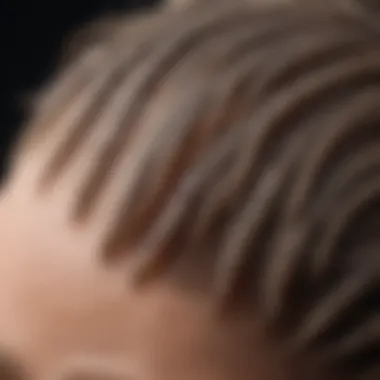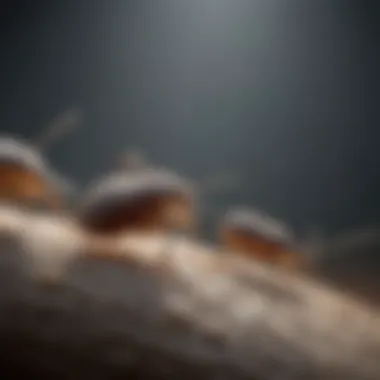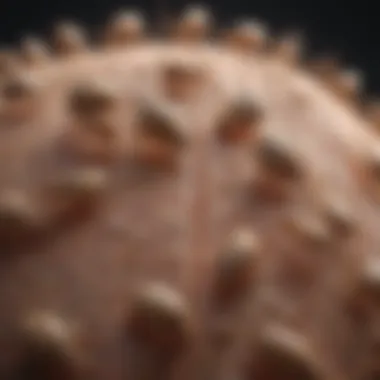Identifying Lice: A Comprehensive Guide


Intro
Understanding lice and their infestations can be quite critical, especially for families with children. These tiny parasites can cause irritation and discomfort, and their presence can lead to unnecessary anxiety. Knowing how to identify lice is key to managing and preventing their spread effectively.
This guide provides a clear structure to help you recognize signs of lice, learn about their biology, examine symptoms, and explore effective detection methods. By taking an evidence-based approach, we aim to empower readers with knowledge on preventative measures and treatment options. This insight will equip parents, educators, and health professionals with the information needed to address lice-related concerns efficiently.
Methodology
Overview of research methods used
The research methodology for this guide involved a comprehensive review of existing scientific literature and articles regarding lice infestations. Resources varied from academic journals to reliable health websites. The data collected focused on the biology of lice, methods of identification, and treatment options.
Data collection techniques
The data collection involved both qualitative and quantitative methods. Primary sources included:
- Peer-reviewed studies on lice behavior and life cycle.
- Interviews with healthcare professionals specializing in parasitology.
- Surveys conducted with parents regarding their experiences with lice.
Additionally, secondary sources included trusted websites such as the Centers for Disease Control and Prevention (CDC) and the American Academy of Pediatrics, providing guidelines for identification and treatment.
Understanding Lice
Lice are small, wingless insects that primarily infest human hair and scalp. Understanding their biology is essential for successful identification and treatment. There are three types of lice that affect humans:
- Head Lice - The most common form, primarily found on the scalp and hair.
- Body Lice - Typically live in clothing and migrate to the skin to feed.
- Pubic Lice - Often referred to as 'crabs,' these lice infest the pubic area but can also impact other body hair.
Life Cycle of Lice
The life cycle of lice includes three stages: egg (nit), nymph, and adult. Eggs are attached to hair shafts close to the scalp, making them easier to identify. Nymphs emerge from the eggs and mature into adults, continuing the cycle. Knowledge of this cycle helps in understanding infestation patterns.
Common Symptoms
Identifying lice may involve recognizing symptoms. Common indications include:
- Intense itching - Often caused by an allergic reaction to louse saliva.
- Red or irritated scalp - Secondary to scratching and inflammation.
- Visible nits - Small, white or yellowish eggs attached to hair shafts.
- Scratched areas - Open sores may appear on the scalp due to excessive scratching.
"Early detection and treatment are vital to preventing the spread of lice among individuals."
Effective Detection Methods
Detection can involve a few straightforward techniques:
- Wet combing - Using a fine-toothed comb on wet hair can help reveal lice and nits.
- Visual inspection - Closely examining the scalp and hair with good lighting.
- Monitoring symptoms - Keeping track of itchiness and irritation levels.
Treatment Options
Once lice are identified, addressing them quickly is crucial. Effective treatments include:
- Over-the-counter shampoos - Such as permethrin or pyrethrin.
- Prescription medications - May be needed for resistant cases.
- Home remedies - Some families opt for natural solutions, though effectiveness can vary.
Culmination
Identifying lice is an essential skill for anyone who may encounter these parasites. Knowledge of their biology, symptoms, and detection methods can make a significant difference in managing infestations effectively. The information in this guide aims to equip readers with the necessary tools. Understanding and addressing lice promptly can lead to a more informed and healthier response to this common issue.
Understanding Lice


Comprehending lice and their behavior is essential for effective management and treatment. Knowing the characteristics of lice, their life cycle, and how they spread helps individuals make informed decisions. Proper identification and understanding can lead to timelier action, reducing the risk of widespread infestation within families or communities.
Definition and Types of Lice
Lice are small, wingless insects that infest the scalp, body, or pubic area of humans. They are obligate ectoparasites, meaning they live on the skin and require blood from a host for survival. There are three primary types of lice that affect humans: head lice, body lice, and pubic lice. Each type has distinct characteristics and preferred habitats.
- Head Lice (Pediculus humanus capitis) are the most common type. They typically reside on the scalp and behind the ears. Head lice are small, about 2 to 3 millimeters in size, and they can cause significant itching and discomfort.
- Body Lice (Pediculus humanus corporis) live in clothing and only move to the skin to feed. They are less common in developed countries and are often associated with poor hygiene and overcrowded living conditions.
- Pubic Lice (Pthirus pubis), often referred to as "crabs," primarily infest the pubic area but can also be found in armpits and facial hair.
Understanding these types helps identify where the infestation is occurring, which is a crucial step in managing lice effectively.
The Life Cycle of Lice
Lice undergo three distinct life stages: eggs, nymphs, and adults. Each stage presents unique characteristics that inform treatment and prevention strategies.
Eggs
Lice eggs, known as nits, are oval and firmly attach to the base of hair shafts. They are usually yellow or white and can be mistaken for dandruff. A key characteristic of nits is their resilience; they are often hard to remove and can survive untreated for several days. Nits hatch after about 7 to 10 days, releasing nymphs into the environment. Understanding the appearance and location of nits is vital for effective detection and eradication.
Nymphs
Nymphs are immature lice that emerge from the eggs. They resemble adult lice but are smaller in size. Nymphs go through three molts before becoming adults, typically reaching maturity in about 9 to 12 days. Their rapid growth cycle allows for quick population increases if left untreated. Recognizing the presence of nymphs is crucial, as they can reproduce and maintain the infestation cycle.
Adults
Adult lice are fully developed insects capable of reproduction. An adult female can lay up to 10 eggs per day, which contributes to the swift spread of infestation. They are about the size of a sesame seed and are dark in color. A crucial aspect of adult lice is their difference in habitat, as they can leave the scalp for temporary periods, only returning to feed. This behavior complicates removal efforts, as they may not always be found on the host.
Lice Transmission and Infestation
Lice are transmitted primarily through direct head-to-head contact, which is common among children. However, they can also spread via personal items such as hats, combs, and bedding. Close quarters, such as schools or camps, heighten the chances of transmission. Understanding these transmission routes aids in the implementation of preventive measures.
Recognizing the importance of understanding lice — from identification to transmission — is key to managing infestations effectively. Knowing the various types and stages of lice, alongside their modes of transmission, empowers individuals to act promptly, minimizing discomfort and disruption.
Recognizing Symptoms of Lice Infestation
Recognizing symptoms of lice infestation is critical for swift and effective intervention. Early identification can help mitigate discomfort and prevent the lice from spreading to others. Lice infestations are common, especially among children, leading to emotional distress and social stigma. Understanding the symptoms allows for timely treatment, reducing the risk of a full-blown infestation affecting family and community.
Itching and Irritation
One of the primary symptoms of lice infestation is itching, which is often caused by the lice feeding on the scalp. The bites can lead to localized irritation, making the affected area feel uncomfortable. Itching is more pronounced in cases of head lice, where the scalp is exposed, but can also occur with body and pubic lice. Individuals may scratch frequently, leading to redness and inflammation. This symptom should not be ignored, as persistent itching can lead to secondary infection if the skin is broken. Therefore, if you notice excessive scratching, it is prudent to inspect for lice and take necessary actions.
Visible Lice and Nits
Visible lice and their eggs, known as nits, are definitive signs of infestation. Adult lice are tiny, about the size of a sesame seed, and are often difficult to spot. However, examining the hair closely, particularly behind the ears and at the nape of the neck, can reveal their presence. Nits are oval and often adhere to the hair shafts, appearing white or yellowish. They can be mistaken for dandruff, but nits are firmly attached and cannot be easily removed. Finding these signs means immediate action should be taken to prevent the infestation from worsening and spreading to others.
Skin Infections from Scratching
The act of scratching due to itching can lead to skin infections, a serious concern in lice infestations. If the scalp is scratched excessively, it may break the skin, allowing bacteria to enter. This can lead to secondary infections that may require medical attention. Symptoms of a skin infection include increased redness, swelling, and pus formation, necessitating immediate intervention. Thus, recognizing the broader implications of lice symptoms extends beyond mere discomfort; it involves understanding the potential health risks associated with itching and irritation.
Methods to Detect Lice
Detecting lice in a timely manner is crucial to effectively managing an infestation. The earlier one identifies the presence of lice, the better the chances of containing and eliminating them before the situation worsens. Various methods exist for detecting lice, allowing individuals to choose the most suitable approach for their circumstances. Each method has its benefits and considerations that play a role in the detection process.
Visual Inspection Techniques
Visual inspection is often the first step in identifying lice. This method involves closely examining the scalp and hair for signs of lice or nits (lice eggs). Individuals can conduct this inspection in a well-lit area, preferably using a magnifying glass to enhance visibility.
Key points for effective visual inspection:


- Section the hair: Part the hair into smaller sections to thoroughly check various areas, especially around the ears and the neckline, where lice are commonly found.
- Look for movement: Adult lice are fast-moving, so it is essential to watch for them as you inspect.
- Check for nits: Nits are small, ovoid, and often yellow or white, often glued to hair shafts close to the scalp.
Effective visual inspection can reveal signs of lice early, avoiding extensive infestation. It is advisable to involve a second person to help with the inspection, as they can see sections of hair that are harder to examine alone.
Using a Fine-Toothed Comb
A fine-toothed comb is another essential tool in the lice detection arsenal. This method can be highly effective when used correctly. The comb's fine teeth can capture both lice and nits stuck in the hair.
Steps for using a fine-toothed comb:
- Wet the hair: Start by applying a bit of conditioner or using damp hair. This can slow down the lice and make them easier to catch.
- Comb methodically: Begin from the scalp and work your way down to the ends. Clean the comb frequently to remove any lice or nits collected.
- Inspect the comb: After each stroke, check the comb for lice or nits. If found, remove them immediately and continue combing.
Using this method helps to confirm any findings from a visual inspection, providing a thorough approach for detection. It is recommended to comb the hair in a brightly lit area for better visibility.
Laboratory Testing Options
In certain situations, especially in severe or persistent infestations, laboratory testing may be necessary. While not commonly used for typical lice control, laboratory testing can assure an accurate diagnosis.
Laboratory testing can include:
- Microscopy: Where samples from hair or skin are observed under a microscope to identify lice or nits.
- Genetic testing: This advanced method can determine specific strains of lice and their resistance to certain treatments.
Though laboratory options require more time and resources, they can provide precise information that aids in choosing the right treatment plan. They can also help address cases where conventional detection methods fail, providing a higher level of assurance regarding the presence of lice.
"Accurate detection methods are vital for effective lice management, ensuring individuals can take appropriate action without delay."
In summary, employing a combination of visual inspection, fine-toothed combing, and laboratory tests provides a robust framework for lice detection. Understanding these methods can inform better decisions in tackling lice infestations effectively.
Preventive Measures
Preventive measures play a critical role in managing and mitigating lice infestations. Understanding how to effectively prevent lice can save families from the discomfort and stress associated with an outbreak. Implementing specific strategies not only reduces the risk of getting lice but also helps in managing existing conditions efficiently. With the proliferation of lice, especially in communal settings such as schools, comprehending and applying preventive measures is essential.
Personal Hygiene and Care
Maintaining personal hygiene is fundamental in lice prevention. Regularly washing the hair and scalp with suitable shampoos helps to remove any lice eggs or adult lice that might settle in the hair. Using a fine-tooth comb during the washing process can improve the detection of nits and lice. This preventative strategy becomes effective when combined with routine checks of family members, especially following close contact with others or visiting places where lice are more prevalent. It is crucial to choose hair products that are not only cleansing but also non-irritating, to promote healthy skin and scalp.
"Keeping lice at bay does not only involve physical cleanliness but also regular supervision of personal items and interactions."
Avoiding Close Contact
Close physical contact poses a significant risk for lice transmission. Lice do not jump or fly, but they can crawl from person to person through direct interactions. Advising children to refrain from head-to-head contact during play or shared activities is an effective preventive technique. Parents and guardians should also emphasize not sharing personal belongings, such as hats, scarves, or hair accessories. In settings like classrooms, promoting awareness can help children understand the importance of maintaining distance to avoid transmitting lice.
Managing Shared Items
Effective management of shared items is crucial in preventing lice infestations. Items that are commonly shared—like combs, brushes, pillows, and bedding—should be thoroughly cleaned and disinfected regularly. If lice are suspected, it is essential to wash any potential items in hot water and dry them at high temperatures to kill any lice and nits. Storing items like jackets and scarves in individual bags can limit cross-contamination in shared environments, making it easier to control infestations. In communal areas such as schools, increasing awareness regarding proper item management can significantly diminish the potential for lice spread.
Treatment Options
Addressing lice infestations is crucial for both comfort and health. Selecting appropriate treatment options can reduce symptoms, eliminate the lice, and prevent future occurrences. Knowledge of available treatments empowers individuals to make informed choices, enhancing their response to infestation.
Over-the-Counter Treatments
Over-the-counter treatments are often the first line of defense against lice. These products come in various forms, including shampoos, creams, and lotions. Most contain active ingredients like permethrin or pyrethrin.
- Accessibility: These treatments are widely available in drugstores or online, making them a convenient choice for many.
- User Guidance: Instructions for application are usually clear, allowing users to follow steps easily.
- Effectiveness: Many people find these treatments effective after a single or double application, although complete removal may sometimes take longer.
- Risks: Potential side effects may include scalp irritation or allergic reactions. It is important to perform a patch test beforehand.
Careful adherence to product instructions is vital. Missing a part of the scalp during application can result in reinfestation, as some lice may survive.


Prescription Treatments
When over-the-counter options fail, prescription treatments may be necessary. Products like malathion and benzyl alcohol are stronger and formulated for severe infestations.
- Effectiveness: These treatments often target lice that are resistant to common over-the-counter options.
- Medical Supervision: A healthcare provider can guide individuals on the most suitable options. This ensures that safety measures are in place, especially for younger patients or those with sensitive skin.
- Side Effects: Prescription treatments may have more pronounced side effects. Users should discuss these risks with a doctor before starting.
While these products can efficiently eliminate lice, proper follow-up is essential to ensure success.
Home Remedies
Many people explore home remedies to combat lice due to either concern over chemical exposure or the belief in natural alternatives. Popular methods include:
- Tea Tree Oil: Known for its insecticidal properties, tea tree oil is believed to suffocate lice when used as a hair treatment.
- Vinegar: Some claim that vinegar can help loosen the glue that holds nits to hair strands, making them easier to comb out.
- Coconut Oil: Its thick consistency is said to suffocate lice, and it also adds moisture to the hair.
- Mayonnaise: Applying mayonnaise to the hair is a common remedy where users believe the thickness blocks the lice's breathing holes.
It's vital to understand that while some may find success with home remedies, scientific support for their effectiveness is varied and often anecdotal. Further research is necessary to validate the claims surrounding these methods.
Regular monitoring is key to ensuring that lice do not return after treatment. Following the right course of action can significantly impact both the immediate and long-term outcomes of infestation.
After Treatment Considerations
After completing treatment for lice, it is crucial to consider several important factors to ensure the effectiveness of the procedure and to minimize the risk of reinfestation. This section addresses monitoring for reinfestation, cleaning and disinfecting personal items, and the significance of communicating with others who may be affected. The foundations of lice management extend beyond the immediate treatments, emphasizing the need for a thorough approach to the entire process.
Monitoring for Reinfestation
Once treatment has occurred, ongoing monitoring is essential to avoid becoming overly complacent. Lice infestations can return quickly, especially in environments where individuals are in close contact. Continuous checks for symptoms should be performed regularly, particularly in the first month after treatment. Monitoring entails:
- Visual inspections: A week after treatment, it is prudent to conduct thorough inspections of the scalp and hair. Look for the presence of nits or live lice, which indicate that further action may be necessary.
- Physical symptoms: Keep an eye out for itching, which may signal that lice are still present, or that new eggs have hatched.
Staying vigilant not only ensures that any reinfestation is caught early but also serves to reassure all parties involved that measures were effective.
Cleaning and Disinfecting
Cleaning and disinfecting are integral parts of post-treatment care. This task helps reduce the risk of lice spreading or returning. It includes:
- Washing clothing and bedding: All items that have been in contact with the infested individual should be washed in hot water and dried using high heat.
- Vacuuming: Frequently vacuuming carpets and upholstered furniture can help in removing stray lice or eggs that have fallen off the person.
- Storage of non-washable items: Items that cannot be washed should be sealed in plastic bags for a minimum of two weeks to ensure survival of the lice is prevented.
By effectively cleaning and disinfecting environments and belongings, the chances of sustaining a lice-free household increase significantly.
Communicating with Others
Communication with fellow household members, caregivers, and close contacts is vital. Clear communication allows awareness and proactive measures to be taken. Important points include:
- Informing others: It is crucial to inform those nearby about the lice infestation. This helps others monitor their own personal hygiene and take preventive measures.
- Education on symptoms: Explain the signs of lice infestations to those around you so they can watch for symptoms in themselves or their children.
- Supporting each other: Providing mutual support can create an environment where information about lice management and treatment is shared effectively.
In summary, addressing post-treatment considerations forms the backbone of effective lice management. Careful monitoring, thorough cleaning, and open communication foster a comprehensive understanding of lice prevention, ultimately protecting individuals and communities from potential infestations.
The End
The conclusion of this article emphasizes the critical understanding and management of lice infestations. Lice can cause discomfort and anxiety, making it essential to thoroughly grasp the processes of identification and treatment. Awareness not only aids individuals in recognizing the signs early but also encourages proactive measures to prevent infestation.
Summarizing Key Points
This guide highlighted several key areas regarding lice:
- Understanding Lice: Knowledge about the definition, types, and life cycle of lice establishes a foundation for further understanding.
- Recognizing Symptoms: Identifying symptoms such as itching and visible lice play a vital role in prompt intervention.
- Methods to Detect Lice: Utilizing proper visual inspection techniques and tools like a fine-toothed comb allows for effective lice detection.
- Preventive Measures: Maintaining personal hygiene, avoiding close contact, and managing shared items contribute to a reduced risk of lice.
- Treatment Options: Exploring both over-the-counter and prescription treatments, as well as home remedies, offers a range of choices for effective lice removal.
- After Treatment Considerations: Monitoring for reinfestation, cleaning, and communicating with others are essential to prevent further outbreaks.
Future Perspectives on Lice Management
As we look to the future, advancements in the management of lice infestations appear promising. Continuous research is crucial. New treatments and preventive measures may emerge that are more effective and less invasive. The integration of digital health tools might improve detection and tracking of lice cases, fostering accountability in dealing with infestations.
- Public health initiatives should further educate communities about lice to reduce stigma.
- Development of non-toxic, environmentally-friendly treatments would be beneficial for users concerned about harsh chemicals.
- Increased awareness and better information channels will support more informed decisions by parents and caregivers.
In summary, proactive management and informed decision-making regarding lice infestations can significantly reduce their impact on lives. Building understanding through education and action can lead to better outcomes in lice management.







